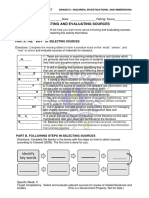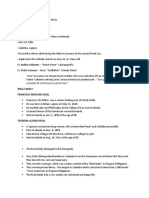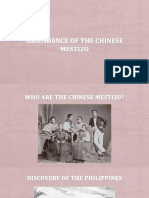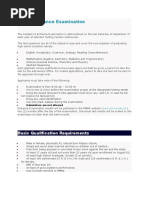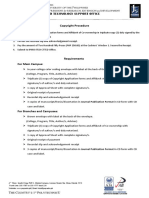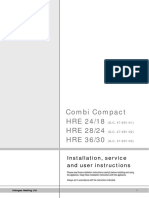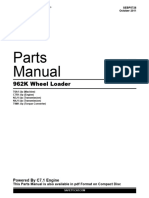(May 2022) IPMO Copyright Procedures and Journal Publication Format
Uploaded by
Jericho Alberto Medrano AggabaoCopyright:
Available Formats
(May 2022) IPMO Copyright Procedures and Journal Publication Format
Uploaded by
Jericho Alberto Medrano AggabaoOriginal Title
Copyright
Available Formats
Share this document
Did you find this document useful?
Is this content inappropriate?
Copyright:
Available Formats
(May 2022) IPMO Copyright Procedures and Journal Publication Format
Uploaded by
Jericho Alberto Medrano AggabaoCopyright:
Available Formats
Republic of the Philippines
POLYTECHNIC UNIVERSITY OF THE PHILIPPINES
OFFICE of the VICE PRESIDENT for RESEARCH, EXTENSION, Planning and DEVELOPMENT
INTELLECTUAL PROPERTY MANAGEMENT OFFICE
Copyright Procedure
1. Fill-out all the Copyright Application forms and Affidavit of Co-ownership in triplicate copy (3) duly signed by the
author/s and have it notarized.
2. Fill-out the recordal slip and acknowledgement receipt.
3. Pay the amount of Three Hundred Pesos (PHP 300.00) at the Cashiers’ Window 1. Secure the Receipt.
4. Submit to IPMO-ITSO-CTTED Office.
Requirements
For Graduate School
Brown envelope with label at the back of the envelope.
(Program, Title, Author/s, Adviser)
Triplicate (3) copy of Copyright Application forms and Affidavit of Co-ownership with
signature/s of author/s and duly notarized.
1 copy of Approval Sheet with complete signature/s.
Original receipt of payment
Recordal slip and acknowledgement receipt
3 copies of manuscript/thesis/dissertation in Whole Manuscript and Journal Publication
Format in CD form with CD case and label.
4th Floor S-407 South Wing, PUP A. Mabini Campus, Anonas Street, Sta. Mesa, Manila 1016
Trunk Line: 335-1787 or 335-1777 local 219
Website: www.pup.edu.ph | Email: ipmo@pup.edu.ph
THE COUNTRY’S 1st POLYTECHNICU
Republic of the Philippines
POLYTECHNIC UNIVERSITY OF THE PHILIPPINES
OFFICE of the VICE PRESIDENT for RESEARCH, EXTENSION, Planning and DEVELOPMENT
INTELLECTUAL PROPERTY MANAGEMENT OFFICE
JOURNAL PUBLICATION FORMAT
Automated Linear Fluorescent Tube Lamp Crushing Machine
Jerry A. Abraham Jr (Abraham) 1, Jericho Alberto M. Aggabao (Aggabao) 2, Khien Levie Belit (Belit) 3, Jonnalyn P. Cortel (Cortel) 4
and Sheige Furio (Furio) 5
Institute of Technology, Polytechnic University of the Philippines, Philippines (Jerry A. Abraham Jr.)
1
Institute of Technology, Polytechnic University of the Philippines, Philippines (Jericho Alberto M. Aggabao)
2
3
Institute of Technology, Polytechnic University of the Philippines, Philippines (Khien Levie Belit)
4
Institute of Technology, Polytechnic University of the Philippines, Philippines (Jonnalyn P. Cortel)
5
Institute of Technology, Polytechnic University of the Philippines, Philippines (Sheige Furio)
6
Institute of Technology, Polytechnic University of the Philippines, Philippines (Mr. Job Vincent Arcebuche)
ABSTRACT
The researchers will buy a salvaged bicycle from a machine shop. Then, they will gather three types of non-functional fluorescent
tube lamps, specifically: 20, 28, and 40 watts. The researchers will get these non-functional fluorescent tube lamps from the industrial
establishments. Afterwards, the unnecessary parts will undergo proper disposal. Thus, the researchers will follow the Waste
Management Facility. This study aimed to determine the rate efficiency of the prototype crushing machine using three different
numbers of watts. Specifically, this study aimed to answer the following questions: (1) Is there a significant difference in the efficiency
rate of the crushing machine using three different trials? (2) In what number of watts has the highest efficiency rate? (3) In what
number of watts has the lowest efficiency rate? In this study, the researchers’ goal is to create a prototype automated crushing
machine that will help in the improper disposal of fluorescent tube lamps. On the other hand, the approach or the strategy used is a
true experimental study. The researchers will demonstrate the procedures on how the tube lamps will be crushed and most especially
by creating the prototype. The researchers may undergo the process of trial and error for the exact way of experimenting. After that,
the researchers will also go into the process of testing their finish product of pulverized tube lamps. By that, the researchers go
deeper and explore the different aspects of the study. The technique helps much to achieve a better result.
I. INTRODUCTION
Fluorescent tube lamps are most efficient and universal for use and installation and have been a common source of lighting
for several establishments and even in local homes. Linear tube-type fluorescent lamps – by far the most common form of fluorescent
lighting but rarely found in residential buildings -- are much more energy efficient than incandescent lamps and are ideally suited to
illumination of large indoor areas of commercial or industrial buildings but this type of lighting had been a concern, considering the
unpredictable occurrence of technical fluctuations near the end of its lifespan and ultraviolet light emission that can lead to critical
health issues.
Furthermore, these lamps had been classified as hazardous wastes due to mercury content - that though in small amounts can
be a threat to the environment when improperly handled or disposed of. In addition, as used lamps were collected as municipal waste
and disposed of in a solid waste landfill, the mercury they contain may be released into the landfill's leachate and then potentially
migrate out the landfill.
Hence, the disposal of used or defected Linear Fluorescent Tubes (LFTs) has been an environmental issue. Governmental
regulations in many areas require special disposal of fluorescent lamps separate from general and household wastes. For large
commercial or industrial users of fluorescent lights, recycling services are available in many countries and may be required by
regulation.
This invention would provide a prototype fluorescent bulb crushing machine that will be essential to solving the problem
regarding the improper disposal of LFT bulbs. Also, the object of this invention is to provide elevated equipment for preventing
undesirable mercury vapors from being discharged into the surrounding air each time the waste receptacle related with the crusher has
to be replaced.
The invention of the prototype bulb crushing machine is unfamiliar here in the Philippines since the people do not give
proper attention to their waste disposal. Thus, these defective lamps, once broken, contribute to environmental pollution. By this, it
will serve as a risk to the people living in the community.
In this study, the researchers aimed to develop a cost-effective, automatic-operated prototype crushing machine which
functions for the efficient processing (pulverize) of used and/or damaged Linear Fluorescent Tube (LFT) bulbs, addressing the issue
regarding the improper disposal of LFT bulbs.
II. EXPERIMENTAL METHOD/S
In this study, the researchers’ goal is to create a prototype automated crushing machine that will help in the improper disposal
of fluorescent tube lamps. On the other hand, the approach or the strategy used is a true experimental study. The researchers will
demonstrate the procedures on how the tube lamps will be crushed and most especially by creating the prototype. The researchers may
undergo the process of trial and error for the exact way of experimenting. After that, the researchers will also go into the process of
4th Floor S-407 South Wing, PUP A. Mabini Campus, Anonas Street, Sta. Mesa, Manila 1016
Trunk Line: 335-1787 or 335-1777 local 219
Website: www.pup.edu.ph | Email: ipmo@pup.edu.ph
THE COUNTRY’S 1st POLYTECHNICU
Republic of the Philippines
POLYTECHNIC UNIVERSITY OF THE PHILIPPINES
OFFICE of the VICE PRESIDENT for RESEARCH, EXTENSION, Planning and DEVELOPMENT
INTELLECTUAL PROPERTY MANAGEMENT OFFICE
testing their finished product of crushed tube lamps. By that, the researchers go deeper and explore the different aspects of the study.
The technique helps much to achieve a better result.
Variables
The variables that the researchers used in this study are the salvaged bicycle which is turned into a prototype machine. Also,
the gathered three types of fluorescent tube lamps may affect the efficiency of the machine. The researchers both needed parts that will
be needed for the machine to be welded. The dismantled parts will be disposed properly with regards to the proper waste management.
After the bulb crushing machine was made, the researcher conducted the actual experiment to test the efficiency of their
Prototype Linear Fluorescent Tube (LFT) Bulb Crushing Machine in using different types of LFT bulbs, with three trials conducted in
varying rotations per minute (RPM).
Data Gathering
Initial Volume ( vi ) of the bulbs were taken before operating the machine. After the procedures have been done, Final
Volume ( v f ) were taken and were subtracted from Initial Volume ( vi ) to evaluate how the machine works.
Formula in finding the volume (m)
2
V =π r (h)
Difference in Volume (D)
D=¿
To calculate the efficiency (E), the researchers used this formula:
output (v f )
E= X 100%
input ( v i )
Data Analysis. The mean was used to determine the average scores of the results of the treatments in this study. The efficiency was
used to evaluate how the machine works in relation to waste, time or energy.
To calculate the efficiency (E), the researcher used this formula:
output (W f )
E= x 100%
input ( W i )
Statistical Treatment. The researchers used Analysis of Variance (ANOVA) table in measuring the difference in efficiency rate of
three different fluorescent tube lamps by three trials.Also, to allow comparisons between different treatment groups that comprise
varying treatment levels. By this, the researchers will know if there are significant changes in response due to treatment or other
factors.
III. RESULTS AND DISCUSSION
This shows the measure of the efficiency rate of the crushing machine that can be useful to other researchers with related studies that
need basis or dependable data for comparison in their study. In this study, we have to find the initial and final weight of the variables,
the output and input, the mean, and the total, variance which will determine the findings for the other researchers that are doing related
studies.
After the bulb crushing machine was made, the researcher conducted the actual experiment to test the efficiency of their
Linear Fluorescent Tube (LFT) Bulb Crushing Machine in using different types of LFT bulbs, with three trials conducted in varying
rotations per minute (RPM).
Table 1A. Initial and Final Weight of 20 Watts Fluorescent Bulbs (g)
RPM Trials Mean
(Wf)
1 2 3 Total
(Wf)
Wi Wf Wi Wf Wi Wf
th
4 Floor S-407 South Wing, PUP A. Mabini Campus, Anonas Street, Sta. Mesa, Manila 1016
Trunk Line: 335-1787 or 335-1777 local 219
Website: www.pup.edu.ph | Email: ipmo@pup.edu.ph
THE COUNTRY’S 1st POLYTECHNICU
Republic of the Philippines
POLYTECHNIC UNIVERSITY OF THE PHILIPPINES
OFFICE of the VICE PRESIDENT for RESEARCH, EXTENSION, Planning and DEVELOPMENT
INTELLECTUAL PROPERTY MANAGEMENT OFFICE
20 125 122 125 124 125 122 368 123
40 125 123 125 125 125 122 370 123.33
60 125 124 125 124 125 124 372 124
Legend:
Wi - Initial Weight (Weight of Fluorescent Bulb before crushing)
Wf - Final Weight (Weight of crushed Fluorescent Bulb)
Table 1B. Computed Difference in Weight of 20 Watts of Fluorescent Bulbs (g)
Trials
RPM Total Mean
1 2 3
20 2 0 3 5 2
40 2 0 3 5 1.66
60 1 1 1 3 1
Table 1C. Computed Percent Efficiency in Weight of 20 Watts of
Fluorescent Bulbs (%)
Efficiency
RPM Mean
1 2 3
20 97.6 99.2 98.4 98.4
40 98.4 100 97.6 98.66
60 99.2 99.2 99.2 99.2
The initial and final weight of 20 watts fluorescent bulbs shown in Table 1.A discloses that operating the prototype machine
at 60rpm obtained the highest output data with a total of 372g and 124g mean for Wf or Final Weight, closest to the constant initial
values (Wi) of 375g and 125g respectively; supported on Table 1.B with a mean of 1g for the computed difference, thus having 99.2%
efficiency shown at Table 1.C.
Percent Efficiency in Varying RPM (20 Watts)
4th Floor S-407 South Wing, PUP A. Mabini Campus, Anonas Street, Sta. Mesa, Manila 1016
Trunk Line: 335-1787 or 335-1777 local 219
Website: www.pup.edu.ph | Email: ipmo@pup.edu.ph
THE COUNTRY’S 1st POLYTECHNICU
Republic of the Philippines
POLYTECHNIC UNIVERSITY OF THE PHILIPPINES
OFFICE of the VICE PRESIDENT for RESEARCH, EXTENSION, Planning and DEVELOPMENT
INTELLECTUAL PROPERTY MANAGEMENT OFFICE
Table 2A. Initial and Final Weight of 28 Watts Fluorescent Bulbs (g)
Trials
1 2 3 Total Mean
RPM
(Wf) (Wf)
Wi Wf Wi Wf Wi Wf
20 185 184 185 181 185 182 547 182.33
40 185 181 185 184 185 183 548 182.67
60 185 182 185 183 185 185 550 183.33
Legend:
Wi - Initial Weight (Weight of Fluorescent Bulb before crushing)
Wf - Final Weight (Weight of crushed Fluorescent Bulb)
Table 2B. Computed Difference in Weight of 28 Watts of Fluorescent Bulbs (g)
Trials
RPM Total Mean
1 2 3
20 1 4 3 8 2.66
40 4 1 2 7 2.33
60 3 2 0 5 1.66
Table 2C. Computed Efficiency in Weight of 28 Watts of Fluorescent Bulbs (%)
Efficiency
RPM Mean
1 2 3
20 99.45 97.83 98.37 98.55
40 97.83 99.45 98.91 98.73
60 98.37 98.91 100 99.09
4th Floor S-407 South Wing, PUP A. Mabini Campus, Anonas Street, Sta. Mesa, Manila 1016
Trunk Line: 335-1787 or 335-1777 local 219
Website: www.pup.edu.ph | Email: ipmo@pup.edu.ph
THE COUNTRY’S 1st POLYTECHNICU
Republic of the Philippines
POLYTECHNIC UNIVERSITY OF THE PHILIPPINES
OFFICE of the VICE PRESIDENT for RESEARCH, EXTENSION, Planning and DEVELOPMENT
INTELLECTUAL PROPERTY MANAGEMENT OFFICE
Data presented at Table 2.A for the initial and final weight of 28 watts fluorescent bulbs revealed highest values, still, at the
rate of 60rpm. With a constant initial value of 185g mean and 555g for total, respective output data after crushing yielded 183.33g and
550g, with the least mean difference of 1.66g shown in Table 2.B and 99.09% efficiency as in Table 2.C.
Percent Efficiency in Varying RPM (28 Watts)
Table 3A. Initial and Final Weight of 40 Watts Fluorescent Lamps (g)
Trials
1 2 3 Total Mean
RPM
(Wf) (Wf)w
Wi Wf Wi Wf Wi Wf
20 275 273 275 270 275 271 814 271.33
40 275 272 275 274 275 273 819 273
60 275 273 275 275 275 273 821 273.66
Legend:
Wi - Initial Weight (Weight of Fluorescent Bulb before crushing)
Wf - Final Weight (Weight of crushed Fluorescent Bulb)
Table 3B. Computed Difference in Weight of 40 Watts of Fluorescent Lamps (g)
Trials
RPM Total Mean
1 2 3
20 2 5 4 11 3.66
40 3 1 2 5 1.66
60 2 0 2 4 1.33
Table 3C. Computed Efficiency in Weight of 40 Watts of Fluorescent Lamps (%)
Efficiency
RPM Mean
1 2 3
20 99.27 98.18 98.54 98.66
40 98.90 99.63 99.27 99.26
60 99.27 100 99.27 99.51
4th Floor S-407 South Wing, PUP A. Mabini Campus, Anonas Street, Sta. Mesa, Manila 1016
Trunk Line: 335-1787 or 335-1777 local 219
Website: www.pup.edu.ph | Email: ipmo@pup.edu.ph
THE COUNTRY’S 1st POLYTECHNICU
Republic of the Philippines
POLYTECHNIC UNIVERSITY OF THE PHILIPPINES
OFFICE of the VICE PRESIDENT for RESEARCH, EXTENSION, Planning and DEVELOPMENT
INTELLECTUAL PROPERTY MANAGEMENT OFFICE
Observations derived for 40 watts fluorescent also revealed highest output values bulbs at the rate of 60rpm. As shown on
Table 3.A, data recorded for total was 821g with a mean of 273.66g, which among the other rates were closest to the initial weight or
input values 825g and 275g respectively. Table 3.B showed a mean computed difference of 4g, as in having 99.51% efficiency Table
3.C.
Percent Efficiency in Varying RPM (40 Watts)
IV. CONCLUSION
Based on evaluated results after conducting experimental procedures, the researcher thereby concludes that the Linear Fluorescent
Tube (LFT) Bulb Crushing Machine is an efficient functional equipment that works satisfactorily in maximum possible number of
rotations per minute and advisable for utilization – aside from being economically cost- effective and environment friendly, the
machine can be operated even in local homes by common individuals, being an potential tool to address the issues regarding improper
disposal of LFTs.
*Appendices/Supplementary Data
Measures
The researchers used a weighing scale in measuring the mass of the three specific watts of the fluorescent tube lamps. Also, a
stopwatch for measuring the time it takes to fully crush the fluorescent tube lamps.
PROCEDURES
4th Floor S-407 South Wing, PUP A. Mabini Campus, Anonas Street, Sta. Mesa, Manila 1016
Trunk Line: 335-1787 or 335-1777 local 219
Website: www.pup.edu.ph | Email: ipmo@pup.edu.ph
THE COUNTRY’S 1st POLYTECHNICU
Republic of the Philippines
POLYTECHNIC UNIVERSITY OF THE PHILIPPINES
OFFICE of the VICE PRESIDENT for RESEARCH, EXTENSION, Planning and DEVELOPMENT
INTELLECTUAL PROPERTY MANAGEMENT OFFICE
Figure 1. CAD Model of Salvage bicycle
Salvaged Bicycle was dismantled to create the chassis for the machine. Hub, pinion, chain, screws, knots, and wheels were
detached from the bicycle.
Figure 2. CAD model of Eight blades
4th Floor S-407 South Wing, PUP A. Mabini Campus, Anonas Street, Sta. Mesa, Manila 1016
Trunk Line: 335-1787 or 335-1777 local 219
Website: www.pup.edu.ph | Email: ipmo@pup.edu.ph
THE COUNTRY’S 1st POLYTECHNICU
Republic of the Philippines
POLYTECHNIC UNIVERSITY OF THE PHILIPPINES
OFFICE of the VICE PRESIDENT for RESEARCH, EXTENSION, Planning and DEVELOPMENT
INTELLECTUAL PROPERTY MANAGEMENT OFFICE
Eight blades were fabricated by cutting a piece of B.I Plain sheet with the use of a metal torch. Blades were arranged
accordingly, with the sharpened end positioned outward and were wielded to the hub. B.I Plain sheet was cut using a metal grinder
forming two circular plates.
Figure 3. CAD model of the enclosure and the inside view
Meanwhile a round, hollow metal piece was cropped from a steel container to serve as the main frame of the enclosure of the
blades. Two holes were pierced at the center of each plate, one was measured corresponding to a B.I pipe gauge attached to one side
of the hub and the other one to fit the free end of the hub and seal in the blades. One of the two plates was wielded to cover one side of
the hollow metal piece.
A piece of B.I pipe was attached to one side of the hub and was inserted on the middle hole of the B.I plate wielded on one
side of a hollow metal piece. A pinion was attached to the free end of the B.I pipe attached to the hub for the blades to turn once the
motors are manipulated. The enclosure was sealed by inserting the other side of the hub into a corresponding hole on the second piece
of B.I plate and tightened it with steel knots, wielding it to cover the case.
Figure 4. CAD model of 2800 Dynamo
4th Floor S-407 South Wing, PUP A. Mabini Campus, Anonas Street, Sta. Mesa, Manila 1016
Trunk Line: 335-1787 or 335-1777 local 219
Website: www.pup.edu.ph | Email: ipmo@pup.edu.ph
THE COUNTRY’S 1st POLYTECHNICU
Republic of the Philippines
POLYTECHNIC UNIVERSITY OF THE PHILIPPINES
OFFICE of the VICE PRESIDENT for RESEARCH, EXTENSION, Planning and DEVELOPMENT
INTELLECTUAL PROPERTY MANAGEMENT OFFICE
A 2800 rpm dynamo was attached to the sprocket of the salvaged bicycle to generate power to turn the blades and start the
process.
Figure 5. CAD model of Circular Plate Attached with Closed Container
There was a container attached to the opening of the filter that served as the passageway for the crushed fluorescent lamps to
ensure the safety of the user. There is a magnet attached on the container to attract the tip metal of the linear fluorescent tube lamps to
ensure that those tips are separated in the crushed product.
All equipment, tools, and mechanical devices used were sanitized and returned to their proper places. Observing segregation,
biodegradable wastes were deposited in waste bins while the collected LFT residues were sealed and delivered to authorized waste
management facilities for disposal.
4th Floor S-407 South Wing, PUP A. Mabini Campus, Anonas Street, Sta. Mesa, Manila 1016
Trunk Line: 335-1787 or 335-1777 local 219
Website: www.pup.edu.ph | Email: ipmo@pup.edu.ph
THE COUNTRY’S 1st POLYTECHNICU
Republic of the Philippines
POLYTECHNIC UNIVERSITY OF THE PHILIPPINES
OFFICE of the VICE PRESIDENT for RESEARCH, EXTENSION, Planning and DEVELOPMENT
INTELLECTUAL PROPERTY MANAGEMENT OFFICE
Figure 6. CAD model of the completed machine set-up
*Author/s note - this contains the following information which may already be shown/footnoted in the first page of the manuscript (1)
author/s full name and affiliation/s (2) email address, permanent house address.
4th Floor S-407 South Wing, PUP A. Mabini Campus, Anonas Street, Sta. Mesa, Manila 1016
Trunk Line: 335-1787 or 335-1777 local 219
Website: www.pup.edu.ph | Email: ipmo@pup.edu.ph
THE COUNTRY’S 1st POLYTECHNICU
You might also like
- Assessment of Bivalves in The Coastal Areas of Aromahan, Basiawan Sta. Maria, Davao Occidental100% (1)Assessment of Bivalves in The Coastal Areas of Aromahan, Basiawan Sta. Maria, Davao Occidental2 pages
- Comparison of The Remineralization Potential of Oyster Shell Powder, Bamboo Salt and Casein Phospho-Peptide Amorphous Calcium Phosphate (CPP Acp) - An Invitro StudyNo ratings yetComparison of The Remineralization Potential of Oyster Shell Powder, Bamboo Salt and Casein Phospho-Peptide Amorphous Calcium Phosphate (CPP Acp) - An Invitro Study11 pages
- Laguna Copperplate Inscription Apostma1992 PDFNo ratings yetLaguna Copperplate Inscription Apostma1992 PDF22 pages
- Pre-Colonial and Rizal's View On NationalismNo ratings yetPre-Colonial and Rizal's View On Nationalism3 pages
- Prof. Hilaria M. Barsabal Cagayan State University100% (1)Prof. Hilaria M. Barsabal Cagayan State University35 pages
- Cavite State University: CEIT R&E Form No. 1No ratings yetCavite State University: CEIT R&E Form No. 110 pages
- The Nature of Theories: Bill Vanpatten and Jessica WilliamsNo ratings yetThe Nature of Theories: Bill Vanpatten and Jessica Williams3 pages
- Lesson 4: Qualitative Approach in Language Research: West Visayas State University/2022No ratings yetLesson 4: Qualitative Approach in Language Research: West Visayas State University/20227 pages
- Did Young Rizal Really Write Poem For ChildrenNo ratings yetDid Young Rizal Really Write Poem For Children7 pages
- The Philippine Islands VOL 1 - Blair Robertson0% (1)The Philippine Islands VOL 1 - Blair Robertson375 pages
- Difference Between PHD by Research and Coursework100% (1)Difference Between PHD by Research and Coursework5 pages
- (Re) Framing Power in The Globalizing WorldNo ratings yet(Re) Framing Power in The Globalizing World7 pages
- PMMA Entrance Examination: Basic Qualification Requirements0% (1)PMMA Entrance Examination: Basic Qualification Requirements1 page
- Letter To The Times Re Climate Change Coverage100% (1)Letter To The Times Re Climate Change Coverage3 pages
- Origin of The Benedictine Sisters of The Eucharistic King100% (1)Origin of The Benedictine Sisters of The Eucharistic King3 pages
- Writing Report Science and Technology in Nation BuildingNo ratings yetWriting Report Science and Technology in Nation Building11 pages
- The Life and Death of Languages: Catambacan, Angela Dumdum, Mariell NicoleNo ratings yetThe Life and Death of Languages: Catambacan, Angela Dumdum, Mariell Nicole36 pages
- Valdivia, Isabella Rachel College Academic Skills in English Section 142 Formative Assessment 9 Comprehension QuestionsNo ratings yetValdivia, Isabella Rachel College Academic Skills in English Section 142 Formative Assessment 9 Comprehension Questions6 pages
- ICT-101 BLIS-1A History of Computer: Pre-20th CenturyNo ratings yetICT-101 BLIS-1A History of Computer: Pre-20th Century7 pages
- (May 2022) IPMO Copyright Procedures and Journal Publication FormatNo ratings yet(May 2022) IPMO Copyright Procedures and Journal Publication Format3 pages
- 6.4.2 Automatic Calibration: 6.5 DR 4 Output The Calculated Adjustment DigitsNo ratings yet6.4.2 Automatic Calibration: 6.5 DR 4 Output The Calculated Adjustment Digits1 page
- Final Part 4 Documentary Report of Work ImmersionNo ratings yetFinal Part 4 Documentary Report of Work Immersion25 pages
- Therm Runaway Test 18650 Li-Ion ClobatoNo ratings yetTherm Runaway Test 18650 Li-Ion Clobato43 pages
- Chapter 5 - Transportation Planning Process100% (2)Chapter 5 - Transportation Planning Process28 pages
- Heart Block Treatment in ParijatakAyurvedaNo ratings yetHeart Block Treatment in ParijatakAyurveda15 pages
- Abraham and Brahma: A Bridge For World Spiritualities To Meet AgainNo ratings yetAbraham and Brahma: A Bridge For World Spiritualities To Meet Again12 pages
- 2 An Introduction To Electronic and Ionic MaterialsNo ratings yet2 An Introduction To Electronic and Ionic Materials4 pages
- Feasibilty Report of Accra Sports StadiumNo ratings yetFeasibilty Report of Accra Sports Stadium20 pages
- SANDVIK DD321-40C Development Drill: Technical SpecificationNo ratings yetSANDVIK DD321-40C Development Drill: Technical Specification4 pages
- Beginners Guide To Hypnosis (Your Questions Answered) - Cal Banyan100% (2)Beginners Guide To Hypnosis (Your Questions Answered) - Cal Banyan12 pages
- Assessment of Bivalves in The Coastal Areas of Aromahan, Basiawan Sta. Maria, Davao OccidentalAssessment of Bivalves in The Coastal Areas of Aromahan, Basiawan Sta. Maria, Davao Occidental
- Comparison of The Remineralization Potential of Oyster Shell Powder, Bamboo Salt and Casein Phospho-Peptide Amorphous Calcium Phosphate (CPP Acp) - An Invitro StudyComparison of The Remineralization Potential of Oyster Shell Powder, Bamboo Salt and Casein Phospho-Peptide Amorphous Calcium Phosphate (CPP Acp) - An Invitro Study
- Prof. Hilaria M. Barsabal Cagayan State UniversityProf. Hilaria M. Barsabal Cagayan State University
- The Nature of Theories: Bill Vanpatten and Jessica WilliamsThe Nature of Theories: Bill Vanpatten and Jessica Williams
- Lesson 4: Qualitative Approach in Language Research: West Visayas State University/2022Lesson 4: Qualitative Approach in Language Research: West Visayas State University/2022
- PMMA Entrance Examination: Basic Qualification RequirementsPMMA Entrance Examination: Basic Qualification Requirements
- Origin of The Benedictine Sisters of The Eucharistic KingOrigin of The Benedictine Sisters of The Eucharistic King
- Writing Report Science and Technology in Nation BuildingWriting Report Science and Technology in Nation Building
- The Life and Death of Languages: Catambacan, Angela Dumdum, Mariell NicoleThe Life and Death of Languages: Catambacan, Angela Dumdum, Mariell Nicole
- Valdivia, Isabella Rachel College Academic Skills in English Section 142 Formative Assessment 9 Comprehension QuestionsValdivia, Isabella Rachel College Academic Skills in English Section 142 Formative Assessment 9 Comprehension Questions
- ICT-101 BLIS-1A History of Computer: Pre-20th CenturyICT-101 BLIS-1A History of Computer: Pre-20th Century
- (May 2022) IPMO Copyright Procedures and Journal Publication Format(May 2022) IPMO Copyright Procedures and Journal Publication Format
- 6.4.2 Automatic Calibration: 6.5 DR 4 Output The Calculated Adjustment Digits6.4.2 Automatic Calibration: 6.5 DR 4 Output The Calculated Adjustment Digits
- Abraham and Brahma: A Bridge For World Spiritualities To Meet AgainAbraham and Brahma: A Bridge For World Spiritualities To Meet Again
- 2 An Introduction To Electronic and Ionic Materials2 An Introduction To Electronic and Ionic Materials
- SANDVIK DD321-40C Development Drill: Technical SpecificationSANDVIK DD321-40C Development Drill: Technical Specification
- Beginners Guide To Hypnosis (Your Questions Answered) - Cal BanyanBeginners Guide To Hypnosis (Your Questions Answered) - Cal Banyan











